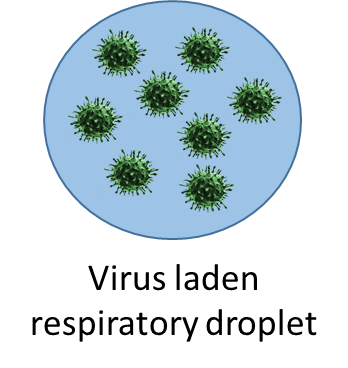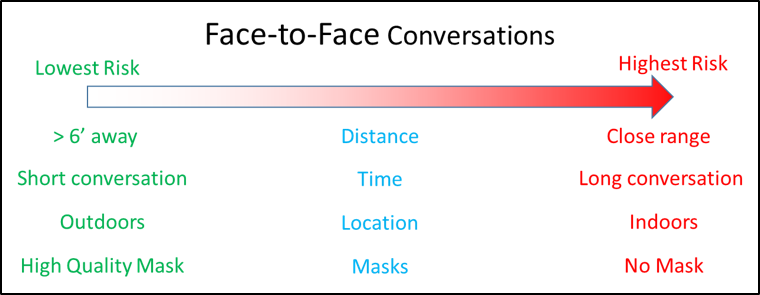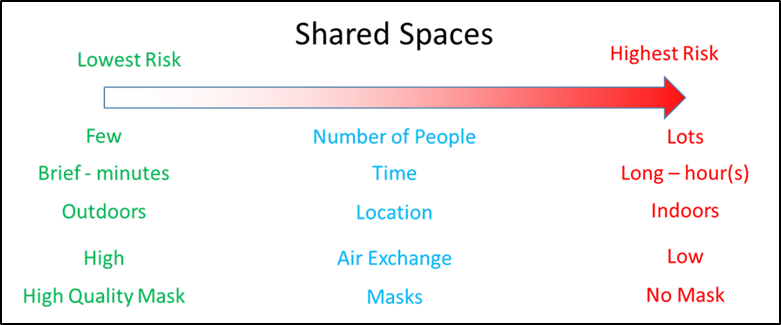What's the deal with Masks?
- Erin Bromage

- May 29, 2020
- 7 min read
Updated: Dec 28, 2021
Masks should not be a political issue. They are a public health issue. But they seem to have stirred up a whole mess of fuss for various reasons. I hope I can break it down simply here and demonstrate their importance in reducing SARS-CoV2 infections in our communities.
When we breathe, talk, yell, sing, cough or sneeze we release respiratory droplets. Tiny balls of mucus that go speeding out our mouth and nose and into the air around us. Those tiny little mucus balls can package up all sorts of fun things - for example, bacteria and viruses. Bacteria are by far the easier ones to see. As an example, my son just finished an independent project for school where he was trying to determine how many bacteria were in a cough. The answer..... there are a lot of bacteria in a cough, even in healthy people!
Image 1. A nutrient agar plate that was coughed on a single time. Each spot on the plate is a bacterial colony that grew over a period of 24 hours.
Viruses are a little harder to measure. You need to catch the droplets and put them in a tissue culture plate containing cells that will allow the virus to grow. The presence of virus in respiratory droplets of infected people has been demonstrated by many labs around the world (not by the 10 year old in my kitchen).
When we speak, those tiny little respiratory droplets are projected forward from our mouth. Hard letters, such a "P" and "K" and "T" project droplets further than the softer letters in our alphabet. The large droplets (100um) hit the ground within 3 feet, the smaller ones within about 6 feet, while the smallest of all (known as the droplet nuclei) can travel great distances. The breathing zone (0-6 feet away) is the high-risk zone for potential infection. If you are within that range, you are inhaling respiratory droplets from the person with whom you are speaking. Outside of that range, the only concern is the smaller droplet nuclei.
The size of the large droplets allow more virus to be packed inside them. In contrast, the small droplet nuclei may only have a few infectious viral particles in each one. However, being smaller doesn't necessarily mean they are safer. Smaller particles, when inhaled, can travel deeper into the lungs than the larger particles - and then find a home in the receptive lung tissue, more easily initiating infection.
Face-to-face conversations
Face-to-face conversations are one of the riskiest things you can do when there is an infectious respiratory disease running rampant in your community. It's even more worrisome when we are facing a respiratory pathogen like SARS-CoV2 that is infectious for up to 5 days before the symptoms show (sub-clinical infectious period).
Distance - The closer you are to another human, the more risky your conversation or interaction will be. Being 6 feet away allows all the larger droplets to hit the floor. Your risk is primarily the virus contained in the droplet nuclei, but the further you are away the more they are dispersed in the surrounding air, resulting in a lower dose, and a lower risk.
Time - The longer you speak face-to-face with someone, the more chance there is to accumulate an infectious dose of virus.
Location - Indoors versus outdoors. Respiratory droplets still hit the ground at the same speed indoors and outdoors. What changes is the distance they travel before hitting the ground. Wind and air conditioning can push the larger droplets further from the person talking. Be mindful of which way the wind or A/C is blowing. Try to speak cross breeze if at all possible so the air pushes the droplets away from both of you and not to towards either of you.
Masks - Wearing a mask while breathing, talking, yelling, coughing or sneezing catches respiratory droplets leaving your mouth and nose. Even with the most basic mask, virtually 100% of the large and medium-sized droplets are caught on the inside fabric surface. As the masks increase in quality, the amount of small respiratory droplets and droplet nuclei that get caught on the inside surface increases.
Quality includes:
How well it fits your face
How much air passes through the fabric (versus up past your eyes/glasses)
The type of fabrics included in the breathing area of the mask
Despite all the publications on mask use, there are no hard and fast numbers to provide. Each mask is different, and the way people wear masks differs. That is why it is so hard for scientists to tell you for certain what your mask should be made of and how effective each type of mask will be. Above all, we scientists like to be accurate, but that is not possible when there are so many confounding variables.
At a minimum, it is believed a good mask will reduce 50% of emissions from the mask-wearer. Multi-layered mixed fabric masks approach filtering efficiencies as high as 90% (Ref).
I want to emphasize that there is not clear evidence to indicate that cloth masks will protect you from inhaling the smallest infected respiratory droplets (those droplet nuclei) from another person. The primary purpose of a cloth mask, when worn by everyone, is to serve as a control for source emissions. If we lower the respiratory droplets coming out of us, we can substantially lower the amount of virus put into the air, thereby lowering the risk to everyone.
My mask protects you - Your mask protects me
Take away for face-to-face conversations:
When 6 feet away, conversations have a lower risk because the majority of respiratory droplets fall to the ground before reaching the other person.
Wearing a mask decreases the amount of respiratory droplets and droplet nuclei released in to the air.
Successful Infection = (Exposure to Virus) x (Time)
If we can decrease the amount of virus released into the air in droplets through wearing masks, we will increase the time in which we can have safer face-to-face conversations
Shared Spaces
I have already discussed in detail the problem with enclosed spaces (See my earlier post on risks and avoiding them). We know that shared spaces increase infection risk with:
the more people that are in that space
the longer time we spend in that space
indoor spaces are more risky than outdoor spaces (due to lack of air exchange indoors)
What role do masks have in indoor spaces?
Indoor spaces allow for the virus to accumulate in the air if there is not adequate air filtration and exchange.
In indoor environments with poor air exchange and filtration, the infected respiratory droplets can spread throughout the room, build up in the air, and, after a sufficient length of time, people sharing that space can inhale enough of a viral load to become infected. However, with mask use, the respiratory emissions are lowered, and you are provided with a greater period of time before reaching an infectious dose. The better the quality of the mask, the greater reduction in respiratory emissions and the longer you can spend in the indoor space safely.
I am an employee/employer where I spend a lot of time in shared spaces, what can I do?
Invest in high quality masks. Look for a mask that has a multi-layer multi-fabric design and an adjustable nose bridge to seal the top part of the mask to your face. The more of your exhaled air that is forced to pass through the mask fabric, the greater the filtering respiratory droplets will be caught inside the mask, and everyone is safer.
Improve the intake of outside air - the more air you can exchange with outside, the lower the viral burden in your space.
Improve the filtration - some HVAC systems can be easily upgraded to have high quality filters included in the system. Potentially upgrade with UV. Consider purchasing portable HEPA filtration systems for smaller spaces where the central system may not be adequate (therapy offices, treatment rooms etc).
I encourage managers to read this article on healthy buildings by Prof. Joseph Allen, to get ideas on how to engineer your spaces more safely.
So next time someone throws a meme at you about masks, you know how to answer it.
Masks are part of the solution to reduce the release of infectious virus into the environment, but they are not 100% effective.
Social distancing works when outdoors and in brief indoor encounters, but distance alone, while indoors, does not protect you from infection.
Face mask use is a social contract. My mask protects you; your mask protects me. But face masks are not perfect and they need to be used in conjunction with other measures to lower risk of infection such as physical distancing and hand washing. There is ample evidence to suggest that widespread use of masks results in significant reductions in the transmission of respiratory viruses. Mask use is grounded in biology and can have a real world and meaningful effect on slowing the spread of infection, protecting your coworkers, and those vulnerable members in your community.
Even 102 years ago, people understood that mask wearing was part of the solution and was a social contract of protecting your neighbor. The photo was taken in 1918 during a Georgia Tech football game played during the Spanish flu outbreak. The other photo was taken last week, and it occurred because mask use has been politicized.
My Mask Protects You; Your Mask Protects Me
Additional thoughts
---- Inhalation filtering. I chose not to address the inhalation filtering capacity of masks. I want to focus on Your mask protects me, My mask protects you. Even the most basic masks do this.
---- Can my fabric masks protect me as well? Yes, some brands provide filtering capacity on exhalation and inhalation, but their effectiveness comes down to how well they fit your face and the material used.
---- Masks with valves. They allow the ejection of your respiratory droplets out through the air port. Possibly at a higher velocity than normal breathing and therefore dispersing the droplets further. While the filter in the port does protect you from infection and the masks do catch your largest droplets, they are not the best option when we are considering a community-minded approach to mask use.
---- Why not wear a N95 or KN95? These high quality respirators provide excellent protection on both exhalation and inhalation, but only if they are fitted properly, and they are not easy to fit properly. All air must pass through the respirator material and the vast majority of people wearing them do not wear them correctly.
---- Wash your mask regularly. Especially, if you are wearing for extended periods. Soap and water is just fine. See my March 30th post on face masks for other tips and tricks.
I found many great articles on mask wearing. If you want to delve deeper into references, please see some of these links.



















"My mask protects you. Your mask protects me." Overall, the information in this blog is right on. But, the statement about above in quotes, while true, is misleading.
When I wear a mask and exhale, my mask wearing doesn't protect you. An exhale puts pressure behind my mask and lifts it away from my face. Especially true if I cough. On the inhale (why my mask definitely protects me), pressure on the outside of the mask is greater than that on the inside. Thus, the my mask seals tighter to my face and protects me from you.
The purpose of distancing and a mask isn't to stop the virus. It's to reduce the viral load you receive. The load is…
Hi everyone, I came across this website by chance, and found it very interesting. I am a geologist and currently working as an author with https://geostudies.org. Interested in studying rocks, their age, and their fossilization. I want to write in erinbromage.com.
Please guide me how to start writing? I have more than 3500 mineral specimens. Here are some links to my recent work.
Quartz; the minerals of silica group
Sodalite Mineral
Minerals of Feldspathoid group
Do My Economics Assignment is now available online. Professional academic assignment writing, editing, and proofreading.
Focusing only on the "social contract" isn't productive. It just makes people angry when they see others not wearing a mask. Focusing on self protection, "My mask protects me no matter what you do", is not only honest, it puts you in control.
It is impossible for a mask that blocks spittle/aerosols to only work one way.
Every cloth mask works both ways equally and it can be argued that it works better as self-protection for multiple reasons (basic physics):
o when you exhale, the pressure inside the mask pushes the mask away from your face.
o when you sneeze or cough, the mask literally jumps away from your face--the seal is lost.
o to get the aerosol or spittle…
No-one ever mentions smoking or vaping outdoors. Smoke and vapour can travel up to 40 to 60 feet if the wind is strong. Are the respiratory droplets simply dispersed to a level we don't need to worry about or has no research been done? Is there anything to worry about and are there any reliable studies to look at?